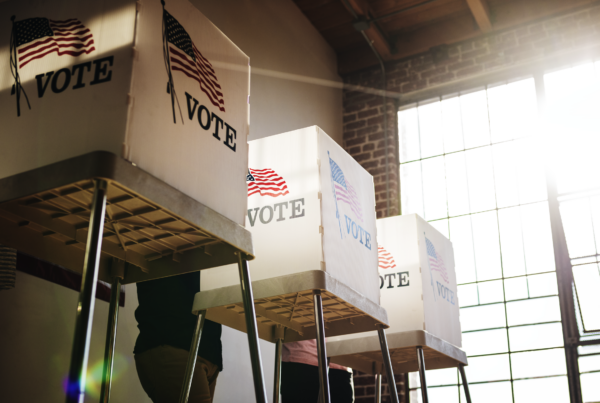Biden Campaign Spends Heavily on Digital Ads
(MIDDLETOWN, CT) May 31, 2024 – Since March 6, spending in the general election phase of the presidential race has been almost evenly split between television ads on local broadcast and national cable television and spending on digital ads on the Meta and Google platforms, according to a new analysis from the Wesleyan Media Project. The analysis looks at spending totals on Facebook (which includes Instagram) and Google (including search, third party, and YouTube) by President Biden and former President Trump, along with their supportive outside groups. Television accounts for over $24 million in ad spending in the general election period, while digital ads on the Meta and Google platforms account for over $23 million in spending (Table 1).
Table 1: General Election Ad Spending (in $Ms)
| Meta | Meta+Google | TV | ||
|---|---|---|---|---|
| Biden | 7.6 | 9.9 | 17.5 | 13.6 |
| Pro-Biden Groups | 0.0 | 0.0 | 0.0 | 2.9 |
| Trump | 1.6 | 3.5 | 5.1 | 0.0 |
| Pro-Trump Groups | 0.0 | 0.6 | 0.6 | 8.0 |
| Total | 9.2 | 14.0 | 23.2 | 24.5 |
| Figures are from March 6 to May 19, 2024 for Meta and TV and from March 3 to May 18, 2024 for Google. Television numbers include broadcast and national cable television. CITE SOURCE OF DATA AS: Vivvix CMAG (for TV) and Google Transparency Report and Meta Ad Library (for digital) with analysis by the Wesleyan Media Project. |
||||
The Biden campaign has outspent the Trump campaign by more than 3:1 ($17.5 million to $5.1 million) on digital ads since March 6. While both the Biden and Trump campaigns have invested more in digital ads than television, groups supporting the candidates have focused their energies on television ads. Pro-Biden groups have spent nothing on Meta or Google but nearly $3 million on television ads. Pro-Trump groups have spent less than $1 million on digital ads, but about $8 million on television ads.
Table 2 presents the same data for the entire 2023-24 election cycle. About $51 million has been spent on digital ads on behalf of Trump and Biden, while $88 million has been spent on television ads. The latter category was aided by $41 million in pro-Trump advertising from groups supporting his candidacy in the Republican nomination, mostly from Make America Great Again, a super PAC. About 64 percent of the Biden campaign’s ad spending so far has been on digital. In contrast, 90 percent of pro-Biden spending from groups (mostly from Future Forward) has been on television ads.
Table 2: Cycle-to-Date Ad Spending (in $Ms)
| Meta | Meta+Google | TV | ||
|---|---|---|---|---|
| Biden | 21.3 | 17.4 | 38.8 | 22.2 |
| Pro-Biden Groups | 0.2 | 1.8 | 1.9 | 18.1 |
| Trump | 3.5 | 5.4 | 8.9 | 6.9 |
| Pro-Trump Groups | 0.1 | 1.7 | 1.7 | 40.7 |
| Total | 25.1 | 26.3 | 51.3 | 87.9 |
| Figures are from January 1, 2023 to May 19, 2024 (for TV and Meta) and to May 18, 2024 (for Google). Television numbers include broadcast and national cable television. Totals exclude spending by or on behalf of other Democratic or Republican candidates for president. CITE SOURCE OF DATA AS: Vivvix CMAG (for TV) and Google Transparency Report and Meta Ad Library (for digital) with analysis by the Wesleyan Media Project. |
||||
In addition to the spending totals for the general election period, the Wesleyan Media Project also examined digital ads by goal. WMP applied a machine learning model (trained on hand-coded ads) to assign each Trump and Biden digital ad a likely ad goal, from a list of possible goals (including persuasion, fund-raising, gathering info on voters, encouragements to learn more, and get-out-the-vote mobilization). The vast majority of assigned ad goals in the general election data were persuasion and fund-raising. Table 3 shows the breakdown of ad spending on Google in the general election period for Trump and Biden, not including supportive outside group spending. 76 percent of Trump’s ad spending on Google was motivated to raise money, while 82 percent of Biden’s was focused on persuading voters.
Table 3: Google Ad Spending (in $Ms) During General Election, by Goal
| Persuasion | Fundraising | Total | |
|---|---|---|---|
| Trump | 0.8 | 2.6 | 3.5 |
| row % | 22.20 | 75.63 | |
| Biden | 8.1 | 1.7 | 9.9 |
| row % | 81.73 | 17.28 | |
| Figures are from March 3 to May 18, 2024 for Google. CITE SOURCE OF DATA AS: Google Ad Library data with analysis by the Wesleyan Media Project. |
|||
Table 4 repeats the process for general election Meta ads. Again, the bulk of Trump spending was focused on fund-raising, but for Biden the balance of spending was different than on Google. About 40 percent of Biden’s Meta ads were persuasion, but 52 percent were focused on fund-raising.
Table 4: Meta Ad Spending (in $Ms) During General Election, by Goal
| Persuasion | Fundraising | Total | |
|---|---|---|---|
| Trump | 0.0 | 1.5 | 1.6 |
| row % | 0.0 | 95.5 | |
| Biden | 3.1 | 3.9 | 7.6 |
| row % | 40.5 | 52.1 | |
| Figures are from March 6 to May 19, 2024 for Meta. CITE SOURCE OF DATA AS: Meta Ad Library data with analysis by the Wesleyan Media Project. |
|||
For more on spending and content on television advertising, click here.
About the Data
Television ad totals reported here are from Vivvix CMAG (unless otherwise specified) and refer to broadcast and national television. All cost estimates for television are precisely that: estimates.
Meta spending data come from the aggregate reports, which provide spending information for each page name and disclaimer combination. Totals in this report reflect spending between January 1, 2023, March 6, 2024, and May 19, 2024. These totals are calculated by subtracting the reported cumulative spending (as reported by Facebook as the total spent since May 2018) for the March 6, 2022 report and subtracting the cumulative spending reported for January 1, 2023, and May 19, 2024.
Spending by Biden includes: spending on the Joe Biden page from Biden Victory Fund, DNC and Biden for President, Biden for President spending on the Biden-Harris HQ and The Daily Scroll pages, Biden Victory Fund spending on the Kamala Harris and Democratic Party pages, and Biden for President spending on the Complex page. Spending by Biden Groups includes Future Forward USA Action. Spending by Trump includes: spending on the Donald J. Trump page by the Trump National Committee JFC, Donald J. Trump for President 2024 and Trump Save America Joint Fundraising Committee, Trump Save America Joint Fundraising Committee on the Team Trump page, and Trump National Committee JFC spending on Lara Trump’s page. Spending by Trump Groups includes Make America Great Again, Inc.
For Google ads, we downloaded the weekly reports from the platform’s Transparency Report. The totals reflected in this release are from the following time periods: January 1, 2023, or March 3, 2024, and May 18, 2024.
Spending by Biden includes the Biden for President, DNC Services Corp, and Biden Victory Fund advertisers. Spending by Biden Groups includes Future Forward USA Action. Spending by Trump includes advertisers Donald J. Trump for President 2024, Inc., Trump Save America Joint Fundraising Committee, and Trump National Committee JFC. Trump Groups include Make America Great Again Inc.
For outside groups, we counted the top spenders on digital platforms, meaning small spending totals by some groups are not included here. For TV, we counted all groups on the Democratic side (minus a few that advocated for candidates other than Biden). For Republican TV totals, we excluded group spending that advocated for other GOP candidates or that were exclusively anti-Biden during the primary phase.
For Tables 3 and 4 figures on goals of advertising in this report, we utilize content information from ads on both platforms and machine classifiers to assess the predicted goal of the ad.
To train our models, we use WMP human coding that classifies ads into several types of goals, including persuasion, fund-raising, contact, purchase, get out the vote, event, polling, gathering information, and learning more. In this report we focus only on the ad goals of persuasion and fund-raising. Random forest classifiers (one model per goal) were trained and validated on an 80/20 split sample of 3,671 human-coded ads. The F1-score performance for each classifier was 85 percent for persuasion and 97.5 percent for fund-raising. The models are binary predictions and therefore it is possible that an ad ID could be identified as both persuasion and fund-raising; however, we assign each ad to its highest probability goal. We apply these classification models to the data from both platforms. For Meta this includes the following text fields: ad creative body, page name, disclaimer, ad creative link caption, ad creative link title, and ad creative link description. Additionally, we transcribe the audio of the videos available from both platforms through automatic speech recognition (ASR), ran optical character recognition (OCR) on the text from image-only ads, and then concatenate the text fields and the transcribed audio together for classification at the unique ad ID level.
About this Report
The Wesleyan Media Project provides real-time tracking and analysis of all political television advertising in an effort to increase transparency in elections. Housed in Wesleyan’s Quantitative Analysis Center – part of the Allbritton Center for the Study of Public Life – the Wesleyan Media Project is the successor to the Wisconsin Advertising Project, which disbanded in 2009. It is directed by Erika Franklin Fowler, professor of government at Wesleyan University, Michael M. Franz, professor of government at Bowdoin College and Travis N. Ridout, professor of political science at Washington State University. WMP personnel include Breeze Floyd (Program Manager), Pavel Oleinikov (Associate Director, QAC), Furkan Cakmak (Post-Doctoral Fellow), Natália de Paula Moreia (Post-Doctoral Fellow) and Meiqing Zhang (Post-Doctoral Fellow).
The Wesleyan Media Project’s real-time tracking in 2024 is supported by Wesleyan University and the John S. and James L. Knight Foundation. The Wesleyan Media Project is partnering again this year with OpenSecrets, to provide added information on outside group disclosure and candidate status.
Periodic releases of data will be posted on the project’s website and dispersed via LinkedIn, Bluesky @wesmediaproject.bsky.social and Twitter @wesmediaproject. To be added to our email update list, click here.
For more information contact: media@wesleyan.edu.
About Wesleyan University
Wesleyan University, in Middletown, Conn., is known for the excellence of its academic and co-curricular programs. With more than 2,900 undergraduates and 200 graduate students, Wesleyan is dedicated to providing a liberal arts education characterized by boldness, rigor and practical idealism. For more, visit www.wesleyan.edu.




